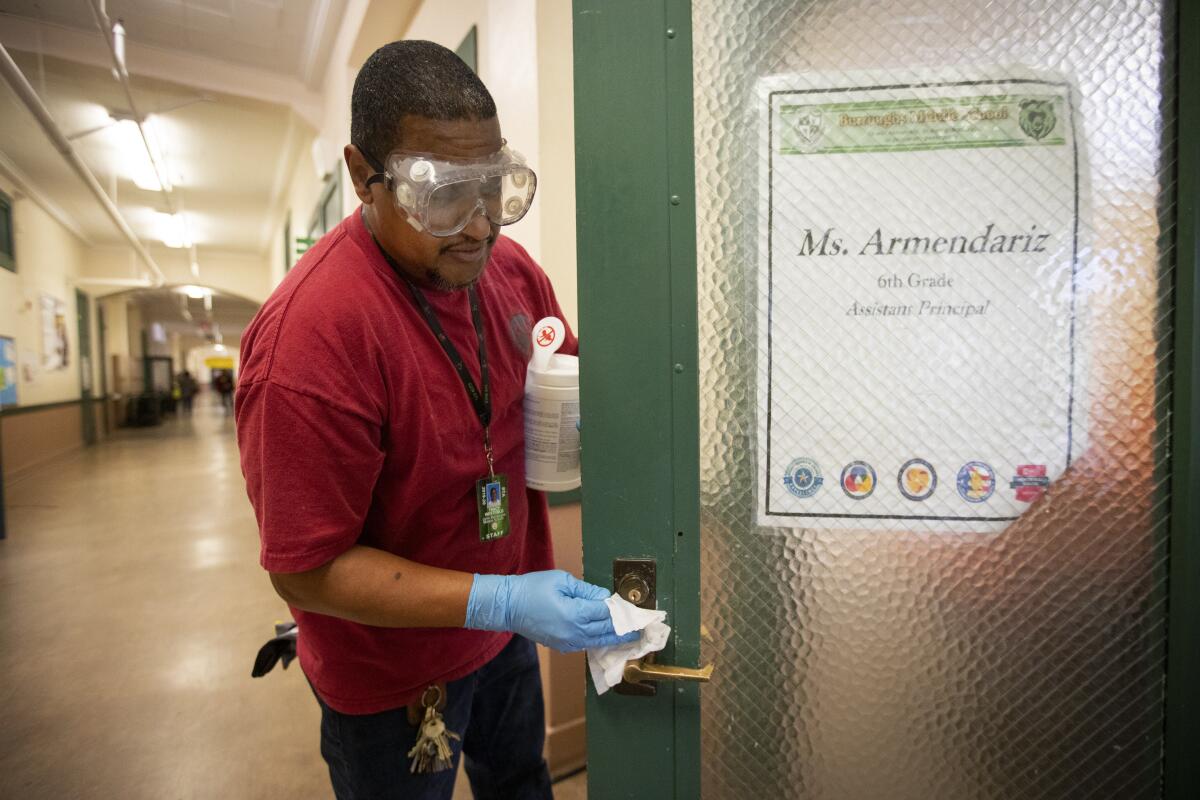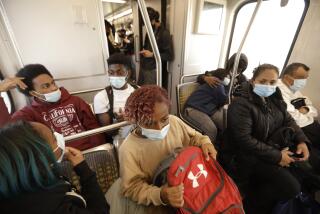Coronavirus hits critical moment in U.S.: 10 deaths, more patients

- Share via
The battle against the coronavirus was reaching a critical moment in the United States, with the number of deaths rising Tuesday as public health leaders said there was limited window to contain the virus.
The death toll in Washington state rose to 10, and Los Angeles and other Southern California communities delcared state of emergency amid new local cases.
“I want them to be prepared for the reality that they, there are going to be more cases in the community,” said Robert Redfield, director of the Centers for Disease Control and Prevention. “But I want them to continue their daily lives. I want them to be mindful of the opportunity again to prepare themselves and their families.”
The World Health Organization announced Tuesday the global mortality rate from coronavirus was 3.4%. The death rate so far — which includes more than 3,000 deaths — is many times higher than the mortality rate of the seasonal flu, which is 0.1%. WHO Director-General Tedros Adhanom Ghebreyesus said that is at least partly because COVID-19 is a new disease, and no one has built up an immunity to it.
Still, he and other health officials said there was still time to slow the spread of the virus.
Officials say they have learned the coronavirus is less transmissible than the flu, which is often spread by people who are infected yet don’t have symptoms. That doesn’t seem to be the case for COVID-19, he said.
“There are not yet any vaccines or therapeutics ... which is why we must do everything we can to contain it,” Tedros said.
Earlier reports have pointed to a mortality rate of about 2% for COVID-19. Experts say they suspect all analyses so far have overestimated the disease’s fatality rate because milder cases are largely not being diagnosed. In 80% of people, the disease causes only mild illness, experts say.
President Trump met with a group of airline executives at the White House Wednesday and tried to reassure the public that it is safe to fly “in large portions of the world.” As public health officials reiterated pleas to wash hands and avoid touching faces, Trump joked about his own practices: “I haven’t touched my face in weeks. In weeks — I miss it.”
Former President Obama also urged Americans to follow the guidance of health officials and remain calm. “Protect yourself and your community from coronavirus with common sense precautions: wash your hands, stay home when sick and listen to the @CDCgov and local health authorities. Save the masks for health care workers. Let’s stay calm, listen to the experts, and follow the science.”
Mike Ryan, who runs the WHO‘s emergencies program, pushed back against officials who wanted to “wave the white flag” and surrender to the disease’s hold. China took drastic steps to fight the virus, he said, and case numbers are now on the decline there.
Countries such as China and South Korea “implemented very, very strong measures that have affected their own economies and their own societies,” Ryan said. “It’s really a duty of others to use the time that has been bought.
“That is not a reverse you can achieve with influenza. If that is a failure, we’ll have slowed down the virus,” he said.
There can be a big benefit in slowing the virus’ arrival in a country for a few months, Ryan said. Many countries, including the U.S, are in the middle of flu season, so large numbers of coronavirus cases would overwhelm the health system.
In Italy, COVID-19 patients and flu patients are already stretching hospitals and healthcare facilities, he said.
Tedros said he’s concerned by shortages of masks, gowns and other equipment needed by healthcare workers to stop the spread of disease “caused by rising demands and hoarding and misuse.”
“We can’t stop COVID-19 without protecting our health workers,” said Tedros, noting that prices of surgical masks have increased sixfold.
Current information suggests that most COVID-19 cases are mild, said Dr. Nancy Messonnier, the Centers for Disease Control and Prevention’s director of the National Center for Immunization and Respiratory Diseases. According to a report from China, the most serious illnesses occur in 16% of cases, she said, and older people and those with underlying health conditions are twice as likely to develop serious outcomes.
Speaking during a media briefing Tuesday, Messonnier said that cases similar to those reported abroad were now appearing in the United States.
The CDC is relying on local health clinicians to determine testing needs. In addition to CDC test kits, commercial manufacturers overseen by the Food and Drug Administration are providing tests directly to states. These types of tests are typically what are on the front lines in the United States, Messonnier said.
As of Monday evening, 60 cases of coronavirus had been diagnosed in the U.S. plus an additional 45 people who were passengers aboard the Diamond Princess cruise ship in Japan and were repatriated to America. That puts the total at about 105 cases, according to the CDC.
The West Coast continues to bear the brunt of the illnesses in the U.S., with the focus on Northern California and Washington state.
Public health officials confirmed a nursing home patient in Washington state was admitted to Harborview Medical Center in Seattle on Feb. 24 and died two days later. The patient, a 54-year-old man who had underlying medical conditions, was transported from Life Care Center of Kirkland and died days before several other patients at the nursing home were linked to the coronavirus, hospital spokeswoman Susan Gregg said.
The Seattle and King County Public Health Department on Tuesday reported two additional deaths from COVID-19, bringing the King County total to eight. The other person who died was from Snohomish County, health officials said.
A North Carolina resident who visited the Kirkland facility has since tested positive for the virus, becoming that state’s first case of COVID-19, Gov. Roy Cooper announced Tuesday. Health department officials in North Carolina are working to identify anyone else who may have come in contact with the individual.
“I know that people are worried about this virus and I want to assure North Carolinians our state is prepared,” Cooper said in a statement, noting that the person represents an isolated case.
More than 50 people in California have the virus, with new cases reported in Santa Clara County, Berkeley and two presumptive cases in Orange County.
There is some debate about how the coronavirus outbreak will play out and its place in history.
The 1918 Spanish flu — the worst pandemic of the 20th century — is estimated to have killed at least 50 million people worldwide over the course of three years. That includes 675,000 in the U.S. Among those who were infected, the death rate is estimated to be greater than 2.5%.
The most recent pandemic flu — caused by the H1N1 virus that emerged from pigs in 2009 — caused between 152,000 and 575,000 deaths around the world. An estimated 12,500 of those fatalities occurred in the U.S. during the first year of the outbreak; an estimated 60.8 million nationwide were infected.
The new coronavirus could wind up somewhere in between, said Dr. Otto Yang, an infectious disease expert at UCLA. Based on what’s known right now, his best guess is that it might resemble the pandemic flu of 1968, which killed about 1 million people globally, including 100,000 in the U.S. That time, the fatality rate for those infected was about 0.03%.
Since 2010, the death toll of a single flu season has ranged between 12,000 to 61,000 in the U.S., according to the CDC. The current flu season, which began in October, has seen about 18,000 deaths so far.
Though the flurry of positive test results in recent days does signal that the virus is circulating within the U.S., experts advised the public to avoid reading too much into those numbers.
Until late last week, federal officials were not allowing widespread testing for the virus, so many people who were already sick are only now being diagnosed, Harvard epidemiology professor Marc Lipsitch said.
“Some of the numbers are changing because new things are happening, but a lot of the numbers are changing because we’re discovering things that have already happened,” Lipsitch said in a forum Monday hosted by Harvard’s public health school. “It’s really important to distinguish ‘Oh, goodness, there’s a new cluster’ from ‘Oh, goodness, we just discovered that there’s a cluster that’s been there for some time.’”
Times staff writers Noam N. Levey in Washington, Andrew J, Campa, Hannah Fry and Anh Do in Los Angeles and Phil Willon in Sacramento contributed to this report. Read reported from Seattle.
More to Read
Sign up for Essential California
The most important California stories and recommendations in your inbox every morning.
You may occasionally receive promotional content from the Los Angeles Times.















